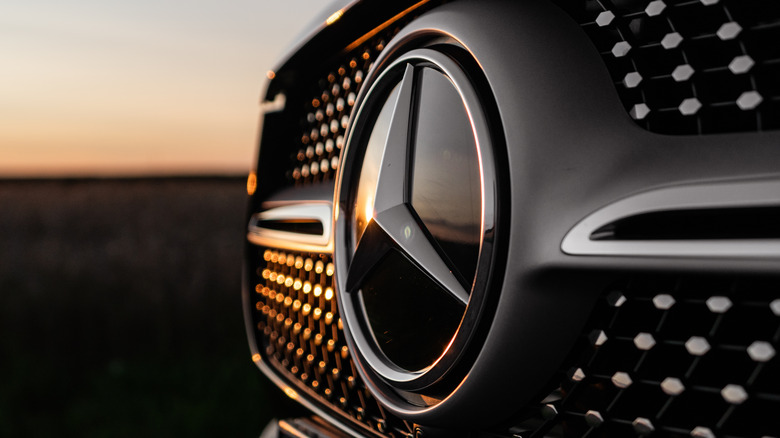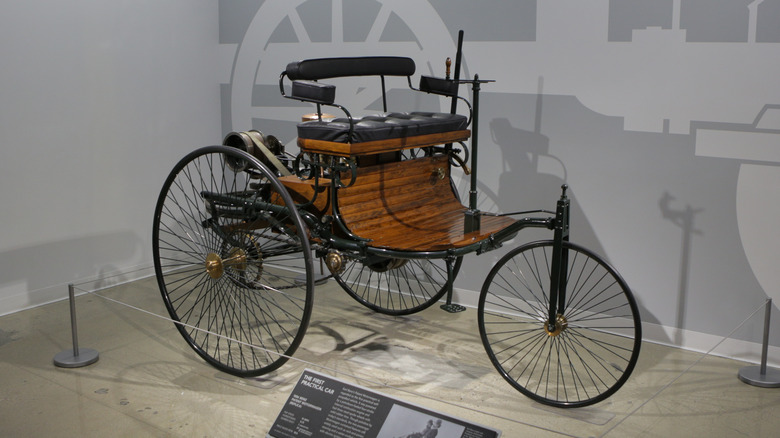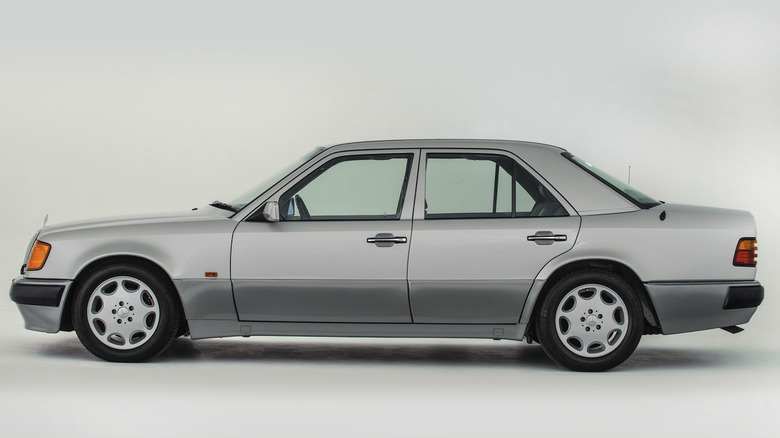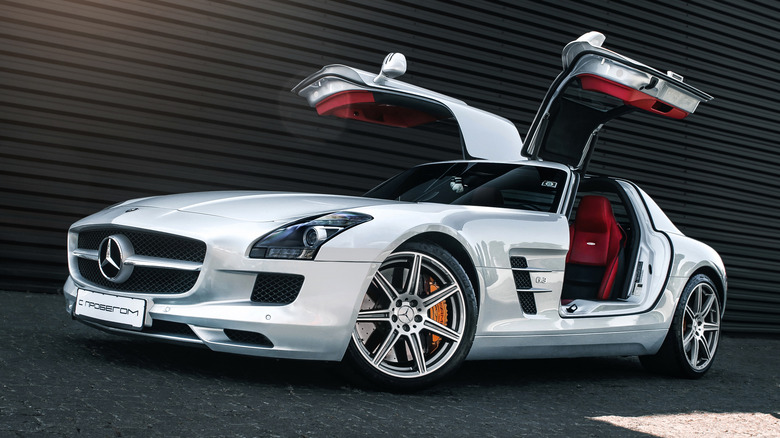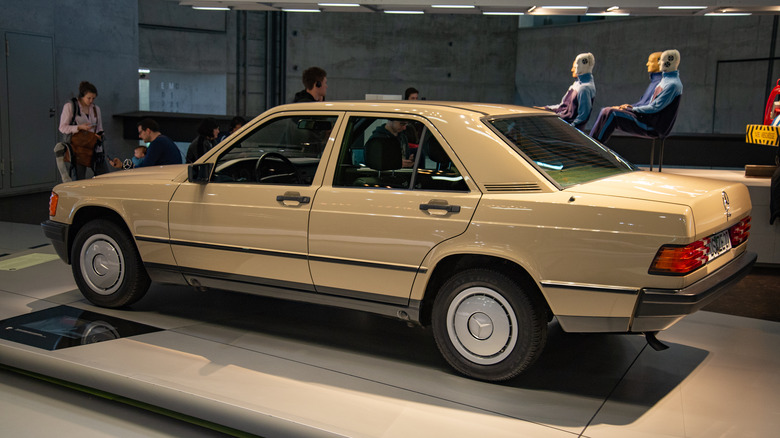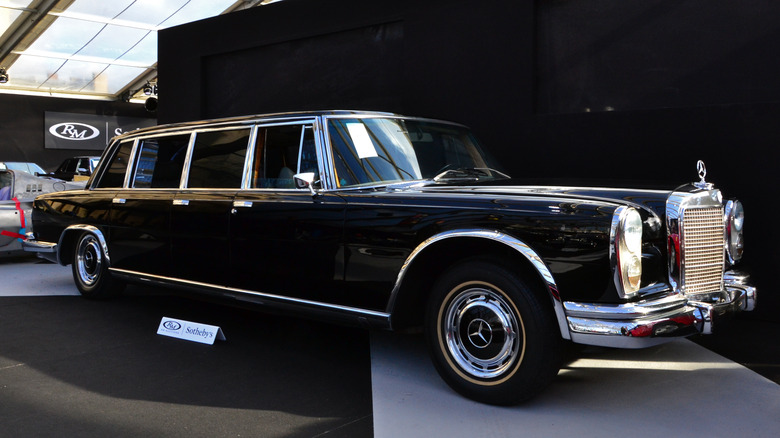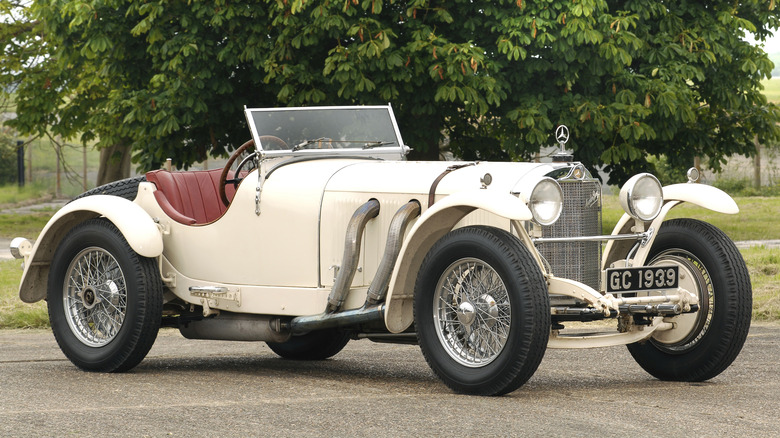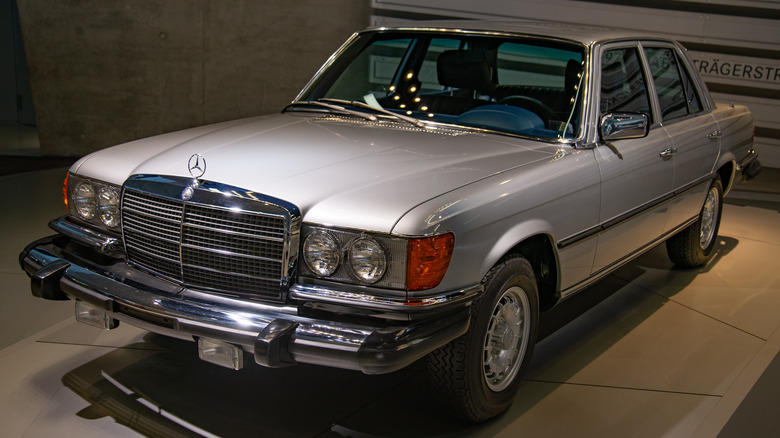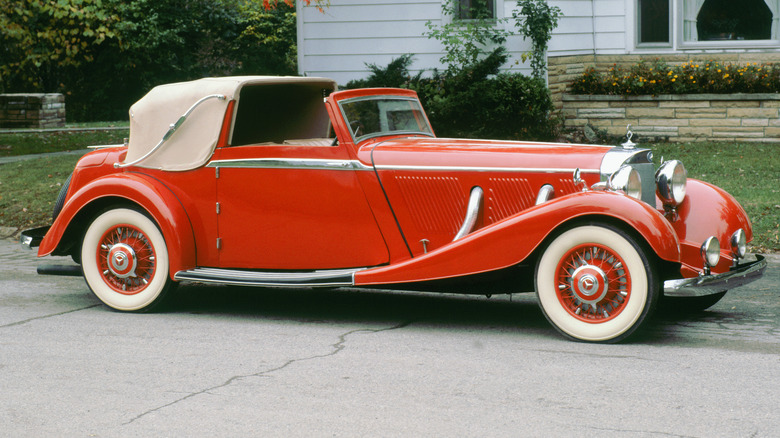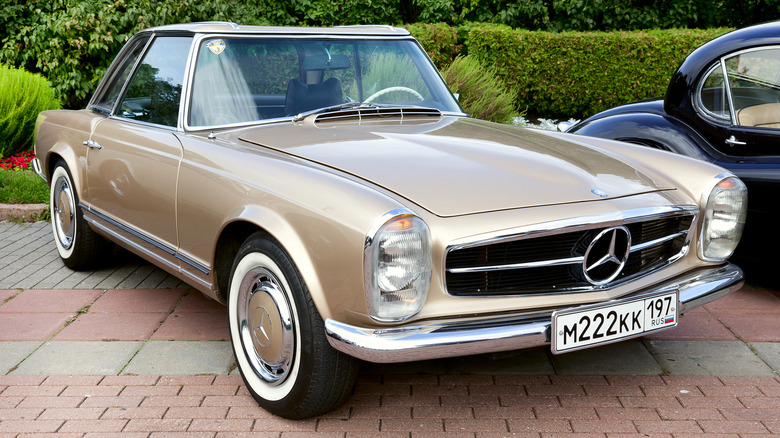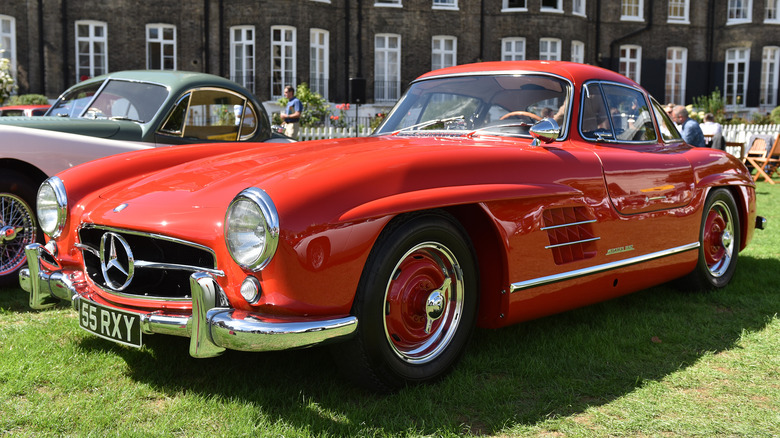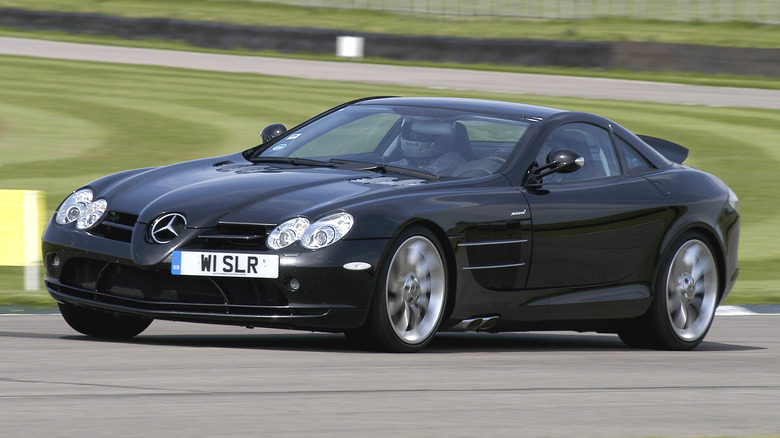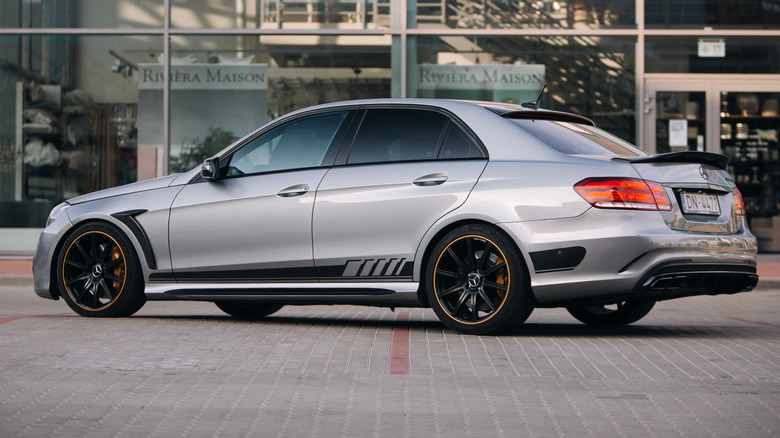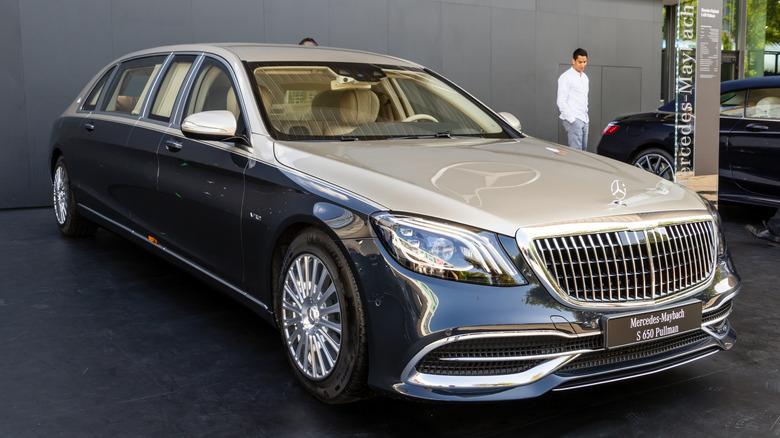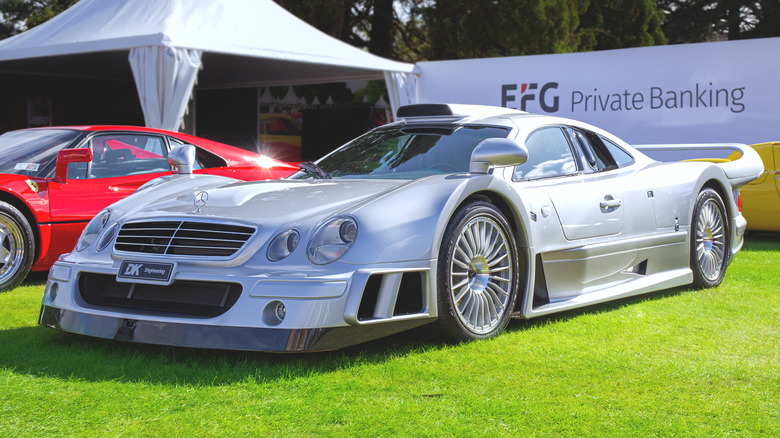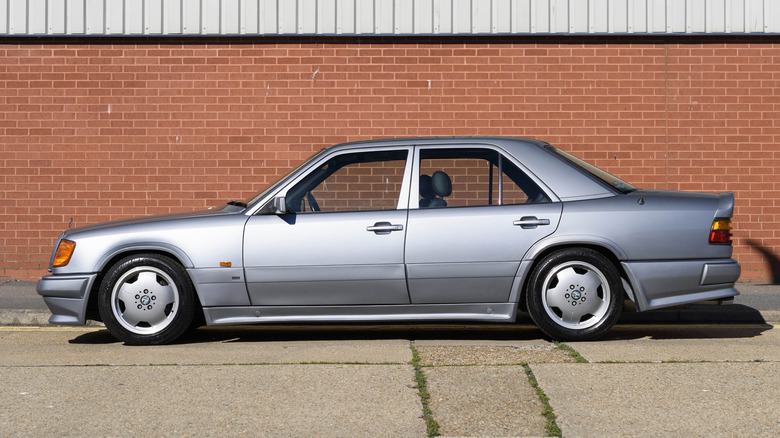The 15 Best Mercedes Of All Time
Mercedes-Benz has a long history of developing and manufacturing some of the most popular — and most expensive — cars in the world. Having established itself as a luxury automaker early in the twentieth century, its reputation is now one of solid engineering and top-tier design.
When making a decision as to what makes a car great, many factors may be assessed. Is it the fastest? Is it the most luxurious? The most popular? All these questions should be asked and answered to determine which models could be considered great, and — with Mercedes' legacy stretching back well over 100 years — deciding the best of the best is no easy task. Taking into consideration the many qualities that people appreciate in any automobile, and concentrating solely on those made available for purchase to the general public — not the company's often-successful race cars, trucks, and other heavy equipment — here are, in no particular order, the 15 best Mercedes cars of all time.
Benz Patent-Motorwagen
No discussion about the greatest Mercedes-Benz vehicles is complete without at least a passing mention of the Benz Patent-Motorwagen. To be fair, it is not a Mercedes-Benz, but without it, no Mercedes vehicle exists and possibly no vehicle exists. Perhaps that is hyperbole, but there is no denying the importance of the Patent-Motorwagen. Developed and built by Carl Benz, the Motorwagen is generally hailed as the first working automobile, as indicated by the date of submission of the patent, 1886.
Mercedes-Benz's official website details the specifications and history of the first car and states that it was powered by a single-cylinder engine of an original design by Carl Benz with a total power output of about ⅔ horsepower. While it proved to be a viable self-propelled vehicle, its first real test was a drive made by Carl's wife Bertha Benz when she drove it with her teenage sons on the first-ever road trip, covering the 66-mile journey from Heidelberg to Wiesloch. Knowing that the car would require publicity to attract buyers, Bertha set out on the journey with Carl being totally unaware of what she was doing. Also, gas stations did not yet exist and the car had a small fuel tank, so Bertha found herself stopping at various pharmacies along the way to find more supplies of gasoline. While the car was certainly not the nicest nor the fastest car, being the first makes it among the best.
Mercedes-Benz 500E
By the 1990s, Mercedes-Benz had firmly established itself as a leader in the manufacture of luxury vehicles. While performance vehicles had not been a core part of their business, the company exhibited a high degree of skill in motorsports and advanced engineering, garnering many wins on racing circuits. The public showed an increasing desire to have refined luxury sedans that were also powerful and agile. To meet this demand, Mercedes set out to build the best sports sedan possible.
Mercedes looked to Porsche to outsource the development of this car, relying on its expertise in delivering high-performance engineering for the road. The 500E used the existing W124 chassis that underpinned the popular 300E model and the Mercedes 5.0 liter V8 engine and suspension components borrowed from the 500SL. The engineers at Porsche widened the body to fit the beefier suspension parts, upgraded the brakes, and reworked the engine to produce a healthy 322 horsepower, according to Hagerty. Because of the wider body panels, the car did not fit in existing Mercedes-Benz assembly lines, so Porsche handled most of the manufacturing using all Mercedes parts. The result is an understated performance car that goes from 0-60 in less than 6 seconds and holds tight through the curves while remaining an unassuming family car in the lot at the country club. It remains a sought-after collectible that still delivers an exhilarating driving experience today.
Mercedes-Benz SLS AMG
As the second car to be developed by AMG, the SLS is a more refined road car than the CLK GTR that preceded it. It is powerful but tame. The 6.2-liter V8 pushed 563 horsepower front to back. The positioning of the engine up front but behind the wheels with the transaxle in the back lends a weight balance that is carefully engineered to be as even as possible. As Mercedes-Benz explains, everything else on the car is built with deliberate intention to make everything light, stiff, and usable. It's a tame beast that can tear down the track or cruise a country road.
With the SLS, the obvious first thing anyone notices is the gullwing doors. Not seen on a production Benz since the 1950s, the doors call back to the original, which are an icon of automotive history. However, in this case, their purpose is more nostalgia than function –- there is no practical reason for making them this way. The glorious wings of the SLS are there for one purpose: they glide upward to make the driver cool. However, looking cool comes at a cost. According to Car and Driver, the original cost of the SLS was north of $200,000 when new, and it's not a car that tends to drop in value. Being a limited-run super high-end Benz, expect its value to appreciate as it ages. Still, it is probably the best Mercedes for someone who wants to look cool.
Mercedes-Benz 190E
A car need not be the fastest, biggest, or most luxurious to be deemed the best. Sometimes, it just has to excel at its purpose for being, as does the venerable 190E. Chief designer Bruno Sacco introduced what would become the dominant design language for the company when he penned the 190. Adopting a now-familiar boxy appearance with an abundance of straight lines and hard edges, the 190 took Mercedes-Benz into a whole new direction, but one that was well received by the buying public.
In addition to being a new look, the 190 signified an attempt by Mercedes-Benz to break into the small car market with the 190E, often called the "Baby Benz." The 190 was not just an exercise in styling but featured many technological breakthroughs in safety. The construction of the car itself utilized high-strength steel and a frame structure meant to minimize the impact of a collision and further protect the passengers in the event of an accident. Shortly after its introduction, a diesel variant was offered with what Mercedes called "whisper diesel" as it had been produced with various efforts to be as quiet as possible.
The 190 proved to be a popular car for those who prefer a smaller packaged vehicle and as an entry-level Mercedes-Benz luxury car. It remained in production for more than ten years with a total output of 1,879,629 units, according to The World of Mercedes-Benz AMG.
Mercedes-Benz 600 Großer
For some people with the means, only the finest car will do. Mercedes-Benz is often the car of choice, but sometimes even they have to step up to the plate for the most demanding of customers. To meet the demand of the chauffeur-driven in the mid-1960s, Mercedes created the 600 Grosser, a stretched limousine with the finest appointments available. Luxury of this caliber is always in high demand by the wealthy. Prominent owners of the car include entertainers such as Jeremy Clarkson, Elvis Presley, and Elton John but, according to GQ, they are in the less-than-savory company of the likes of Chairman Mao, Idi Amin, Saddam Hussein, and Kim Jong-un. It is quite the cast of characters.
Evil dictators aside, the car was developed to be the pinnacle of luxury. It's equipped with a complex hydraulic system preparing the car for handling all manner of terrain while keeping up a sublimely smooth driving experience. The power windows are also driven by the hydraulic system and are powerful enough to take an arm off. It also features a hydraulic power trunk lid, power seats, sunroof, and doors (via Motor Biscuit). It's propelled by the first Mercedes production V8, producing 250 horsepower from its 6.3-liter displacement. The list of custom extras is long and would have been limited only by imagination and limits of the technology of the time. There is a reason it was so popular with heads of state and rock stars. It was the best.
Mercedes-Benz SSK
Mercedes is most often discussed in reference to the fine luxury automobiles they produce today but it is a company with well over a century of history and many cars of its past are worthy of such talks. Among those cars is the SSK, a super sports car that existed possibly before anyone knew to call it as such.
Before Dr. Ferdinand Porsche did his iconic work on the peoples' car for the most unsavory character of modern times, he designed cars for Mercedes-Benz according to the Revs Institute. Among the most magnificent of those creations is the SSK in the late 1920s. The greatest of this line of cars is the 1931 SSKL, powered by a supercharged 7 liter inline six-cylinder engine equipped with a roots-type supercharger (via Mercedes-Benz). With this engine, this car produced 300 horsepower in 1931. In that day, an ordinary car only had around 30 horsepower, making the SSK truly extraordinary. Porsche's design is as aesthetically pleasing as it is powerful. As Mercedes recounts, the SSK performed well on the track and brought its drivers many victories, proving early on how great a Mercedes-Benz car could be.
Mercedes-Benz 300SD
Mercedes-Benz is a trailblazing company in the automotive world and they have patents for dozens of novel technologies. As such, many of its cars set precedents other makers would later follow in their own products.
While Mercedes had a history of producing diesel cars that stretched back to the 1930s, the 1978 300SD marked the first time for an automaker to offer a turbocharged diesel engine (via AutoWeek). Diesel cars made prior to this one were most often characterized by their defining feature; they are slow. They are abysmally slow, for that matter, but the inclusion of the turbo meant the new engine produced enough power for the car to have reasonable, or at least acceptable, performance according to MotorTrend.
The 5-cylinder turbodiesel engine produced about 120 horsepower, which sounds very low by today's standards but the late 1970s was an era when sports cars struggled to reach 200 horsepower. Otherwise, the car was typical of Mercedes cars for the time and is known for having legendary reliability and the strongest and highest build quality, meaning well-kept examples of these cars are known for driving hundreds of thousands of miles and still running strong. For instance, a 1980 300SD discovered in a junkyard by AutoBlog clocked more than 300,000 miles before the end, and that's likely on the low side. The 300SD is still known today for being the car that will outlast us all.
Mercedes-Benz 500K Special Roadster
Classic and antique Mercedes vehicles are often a thing of beauty and the 500K Special Roadster is one such example. Described by the manufacturer as a "dream car," the 500K was a hand-crafted masterpiece of automotive luxury. Taking 5 months to build at a cost equivalent to a luxury villa in Berlin, Mercedes-Benz produced only 30 of these special cars and adorned them with the finest craftsmanship possible. The gauges of the dashboard are surrounded by exquisite artificial mother-of-pearl with seats upholstered in fine leather.
Technology played a significant role in the car as well, and as Forbes lays out, the propulsion is courtesy of an inline eight-cylinder engine equipped with a supercharger capable of producing 160 horsepower. With this engine, the 500K was capable of going 100 mph, among the fastest of cars in the post-depression era. Other cutting-edge features include hydraulic brakes, a 12-volt electrical system, and electric power locks. Furthermore, with such an exclusive, hand-built car, custom bodywork was on offer as this car catered to those who could and would ask for special and unique treatment. With the rarity and age of the 500K, like other truly great Mercedes vehicles, the rare moments these see an auction gavel, the bids run over $2 million if they ever do come up for sale.
Mercedes-Benz 230SL Pagoda
Choosing to pick the most beautiful Mercedes-Benz model ever made would be a difficult choice, but the 230SL of 1963-1971 would be good competition. Following up on the 300SL coupe and 190SL roadster, the 230SL removed some of the more dramatic curves of the fifties and applied a more reserved, yet striking design to the new car. While the "Pagoda" moniker is not official, it is used so widely and so often it seems as though it is. The name comes from the resemblance of the removable hardtop to the rooflines of a Japanese pagoda.
Specifications for the car (as reported by UltimateSPECS) are impressive. The new car raised the cylinder count to 6 and raised the displacement from 1.9 liters to 2.3. The 230 received the same mechanical fuel injection system as the 300SL and this powered the car with a healthy 150 horsepower, which was more than adequate for a car of its size. To increase rigidity, the body panels are spot welded to the frame, rather than being bolted on. While this can help to reduce flex in the corners, Driving claims repairs can be a costly affair.
The understated style of the 230SL is undeniably its strong suit. Selling for around $7,000 in 1963 meant that buyers were a select group. While remaining specimens in good order may not set records at Christie's or Sotheby's, MotorAuthority notes they can still exceed most auctions by well over $50,000.
Mercedes-Benz 300SL
Among iconic automobiles, the Mercedes-Benz 300SL is a legend. The dramatic sculpted curves and gullwing doors make it one of the most recognizable and coveted cars in existence. Its origin lies on the race track as it was the first race car developed by Mercedes after the war. The gullwing doors are a dramatic and iconic feature of the car, but they were borne out of necessity. According to Mercedes, the tube frame was constructed to allow for maximum torsional rigidity while keeping weight down to just 50 kilograms (110 pounds). However, due to the shape of the frame, cutouts for doors were not possible and created the need for an innovative solution, which led to gullwing doors.
Appearance alone makes the SL a desirable and iconic vehicle, but its racing roots ensured that performance played an equal part in making it a great car. Mercedes-Benz already had a very good inline 6 cylinder engine, and it had been tuned with the use of mechanical direct fuel injection to produce 220 horsepower. This was powerful enough to make such a light car fast for its time, but it was also the first production car sold with a fuel-injected engine.
Today, the 300SL remains one of the most desirable cars on the planet. Its stunning beauty and aged opulence make it one of the best Mercedes vehicles, with Robb Report noting existing models can sell for millions when they do come up to auction.
Mercedes-Benz SLR McLaren
Teaming up with a partner can help automakers produce special vehicles they would not ordinarily come up with. These collaborations between legacy companies with smaller boutique manufacturers in which they own an interest, such as GM and Lotus, have led to all manner of interesting projects. At the time that Mercedes-Benz owned a significant portion of winning racing team and engineering firm McLaren, their collaboration yielded an extremely special project.
Dubbed the SLR McLaren, an homage to the SLR racing cars of the fifties, this car blends the best of Mercedes luxury with McLaren engineering. Per Car and Driver, it features a supercharged V8 engine hand-built at the McLaren facility in Woking, England, and makes a healthy 617 horsepower. Motor Trend timed its acceleration to 60 mph at 3.6 seconds. It is properly quick, especially for a front-engine and rear-drive car.
Furthermore, their testers gushed on its ability to hit a track at blistering speed, yet remain refined and comfortable on the road. Unlike supercars with extra firm rides that cause pain and stiffness after a modest drive through the mountains, the SLR is sophisticated, comfortable, and refined. It hits the mile markers as fast as you want and shows up to the country club without breaking a sweat. It's a near-perfect car for a car lover of means. With recent auctions hovering between a quarter and half-million dollars (such as this listing with Stratas), the means of said car lover will need to be substantial.
Mercedes-Benz E63 AMG
Dreaming about wildly expensive supercars can be great fun for many folks, but the option to drive one may never come. This is especially true of the iconic classics we can only enjoy watching across the auction block of a Mecum auction. Still, a great many people who have achieved even modest success and want to indulge in their motoring passion have an option that is just a little more attainable than a priceless roadster from a bygone era.
The Mercedes-Benz E63 AMG is an upper-middle-class tedium slayer. With such impressive specifications as a twin-turbocharged DOHC 32-valve V-8, aluminum block and heads, direct fuel injection, and 4MATIC all-wheel drive (via Car and Driver), the E63 is a suburban subdivision rocket. Available in sedan or wagon body style, it is a 603 horsepower grocery-getter the whole family can love. Also equipped with all the luxury expected of a modern luxury sedan, this car does it all in style. It could certainly be considered the best family car for the family who likes to go fast.
Mercedes-Maybach S-Class
Most could or would say that the Mercedes-Benz S-Class is about the most luxury on four wheels money can buy. They would be wrong. That is to say, they would be wrong if they did not mention the absolute top-of-the-line S-Class, the Mercedes-Maybach S-Class. This car is the luxury car for the people who sign the checks that rich people cash.
For around $200,000, the Maybach offers many things, but especially attention to detail. Besides having power-operated everything, little touches throughout the cabin abound. The fluffy leather tufted seats wrapped in soft leather cradle passengers front and rear, even coming with matching neck pillows for those in back. Screens for rear occupants show a wealth of information and give rear-seat riders controls of music, maps, climate control, and overall comfort. It is a car for which a passenger will want for nothing, except possibly a slightly longer journey to enjoy the ride.
Per Mercedes-Benz, technical details about the car include a twin-turbo 500 horsepower V8 engine with mild hybrid drive driving the 4MATIC all-wheel-drive system through a 9-speed automatic transmission. The car includes adjustable LED lighting throughout, many touchscreens with haptic feedback, rear-seat neck heating, rapid-heating rear seats, a complex fully adjustable climate control system, soft close doors, and the list goes on and on. The car is loaded with every luxury possible, and if that is what you think makes a car great, then this car is the best.
Mercedes-Benz CLK GTR AMG
With the experience building race-ready engines firmly established before formally joining Mercedes-Benz, AMG became the in-house tuner for all manner of racing projects for its parent company. One such project became a race-winning champion that a lucky few could drive and call their own, the CLK GTR.
Created for the GIA GT Championship, the CLK GTR was a race car first, and a road car second. Specifications for the car (via AutoEvolution) are as impressive as one would expect for a race car, with a mid-mounted 6.9 liter naturally aspirated V12 pumping out more than 600 horsepower. While that sort of power may be fairly common on supercars today, in 1997 it was a staggering amount of power.
To complement the massive power output, everything on the car is built for speed, with aluminum and composite materials used abundantly to create a body and chassis as light and rigid as possible. Creature comforts are non-existent as the interior is cramped and without any amenities. But it is fast. It is also expensive. Only 25 examples of the car were made and today auctions for the car - such as this listing with Sotheby's – drift into the multi-million dollar range. If the best car from an automaker is gauged solely on speed, this one is the best by far.
Mercedes-Benz AMG Hammer
Following the release of the 190E, Mercedes-Benz followed up the new direction in styling with the W124 300E. Taking the same boxy design cues and shifting them onto a larger platform, Mercedes-Benz released its full-size sedan with its trusted inline six. While the 300 was plenty of car for the average banker or podiatrist, Mercedes obviously thought some might like a little bit more.
Starting out as two guys who liked to make cars — specifically Mercedes-Benz cars — go fast, AMG evolved into a specialty manufacturer of performance parts and engines for racing and custom passenger vehicles, according to AMG's own retelling. Their success led to Mercedes contracting their company to modify the new 300E sedan into a performance variant to be sold and officially supported by Mercedes dealers. The result is the AMG Hammer, which Road & Track describes as a 300E fitted with an AMG 6.0-liter quad-cam V8 spitting out more than 375 horsepower. This propelled it to 60 mph in 5.3 seconds, an impressive figure for the late eighties.
In addition to the powerplant, the cars received mild cosmetic upgrades and special touches to the interior such as an AMG steering wheel and nicer seats with better bolstering for the corners. The Hammer could have just as well have been named the Rocket, as it represented the leading edge in high-performance German engineering, and remains a sought-after special edition car today with a recent example selling for a pretty penny at Sotheby's.
